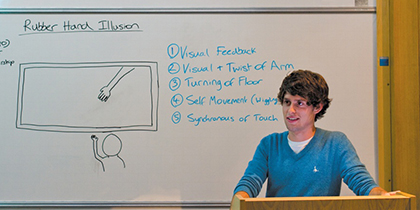"Seeing the Text" By Stephen Bernhardt
"The Multimedia of Texts" By Anne Wysocki
Stephen Bernhardt speaks my language. I feel the premise of his essay surrounds breaking the convention of feeding students one form of writing and expecting purely non-visually informative compositions. Unfortunately for the educations systems there are many different types of persuasion and "rhetorical organization," as Bernhardt identifies it.

This terminology, "rhetorical organization," makes me want to analyze how Bernhardt defined it. Based on what I understand about rhetoric, I find this term linked with the persuasive elements of how we interpret text. Bernhardt writes, "
He seems to have a problem with the "conventional essay format," which rarely sees visual components. He writes, "A preoccupation with conventional essay format allows little attention to visual features. Instead of helping students learn to analyze a situation and determine an appropriate form, given a certain audience and purpose, many writing assignments merely exercise the same sort of writing week after week, introducing only topical variation” (77). He appears to be suggesting that rhetoric has foundations in determining the appropriate form for a persuasive composition, and depriving students of the opportunity to decide what form best suits the need of the composition, we're fundamentally teaching them nothing about what options they have for employing rhetoric to their advantage. I also find it somewhat perturbing that most educators exclusively assign non-visually informative compositions from students.
However, it's worth addressing the problem of non-visually informative texts being consistent, which is the aim of many educational systems, consistency. Consider in simple terms a high school English classroom, a place most familiar to me from being there as a student and a substitute teacher more recently. A high school English teacher assigns students an "project" rather than an "essay," and students can make a video, a poster, or some other form of presentation to demonstrate their knowledge about whatever book they've been reading. Let's say students are relatively creative and make some posters, a short film, one writes a song, another does a re-enactment from a scene in the text. Now, the problem of grading. At a high school level, where standards are rigorously enforced, the grading scheme can't always be based on effort, but on content. There are no standards for grading content. It's all up to the discretion of the teacher to assign grades to each of these nonlinear projects that students have worked on and composed. Consider the other teacher who assigns his/her students "essays" and not "projects." He/she takes away a bit of creative demonstration from the students, but the exchange is that they receive a pile of papers that A) use a consistent grading scale, B) all likely possess similar points, and C) can be graded based on a standard that has been applied to years and years of high school educators. Which is easier? Which is more expressive and entertaining? Which will stimulate students' interest most effectively?

The main point to take away from this essay, in my opinion, is that it's unconventional to use visual features for conventional student compositions. The conventional essay is the preferred method, but this prevents students from learning how to experiment with form, purpose, and audience. It limits their expressive abilities and fits them into a margin. Persuasive elements come in a variety of forms and it doesn't end with Bernhardt's exploration of visual components.
Now, to address Wysocki. Her essay seemed to be like a form of style-guide for visual rhetoric, how "...visual elements and arrangements of a text perform persuasive work” (124). She outlines all the possibilities of using text, shapes, organization of pages, how they all play off of one another. Her detail is astounding, but the punchline from all that appears to be quite similar to what Bernhardt is suggesting, that visual aspects of text can be understood as being just as rhetorically effective for an audience as "conventional text." This rarely-explored avenue for persuasion features a composition process with just as much, if not more, specificity as to how the rhetorical effect is employed in relation to conventional forms of rhetorical persuasion, in modes ranging from organization to purpose to audience considerations. It all matters when employing rhetoric.
I really like your analysis here of the main themes of the text. Visual elements, I would say also add a different kind of persuasion to a body of text or work. It kind of says "here, look for yourself" and invites audiences into the investigation to see the facts and discover/get convinced on their own rather than being shoved or pulled into suggestions or ideas. At least, that's what it made me think of. -Amanda
ReplyDeleteHey Matt,
ReplyDeleteI agree with your statement that using visual features for a student's written projects. I think you could definitely be right as far a student being being able to learn more from form, purpose and audience. My question is if it's even considered traditional writing at that point; any uncertainty about that has to bother a lot of people in the field of writing studies, but probably excites a large amount as well. I guess it's evolution but it's interesting to think about the small difference between typing this on a computer and using a pencil and paper. Is it still writing if I use the computer?
I like your comparison of the teacher who assigns a creative project and the one who assigns a paper. Would you consider that in an environment where grades are strictly regulated that it's more fair to the students to all do papers instead of creative projects? Creativity is harder to grade than a standard essay and some students don't have the same resources as others, so obviously an essay would be easier right?
ReplyDeleteI think students should definitely be provided with opportunities to flourish and grow creatively and I think students are more likely to participate in that type of assignment, but would a grade of this type of project grade on quality? Quantity? Overall hours put into the project? Actual creative input? I think most instructors stray away from creative projects because they just don't want to deal with the grading process.